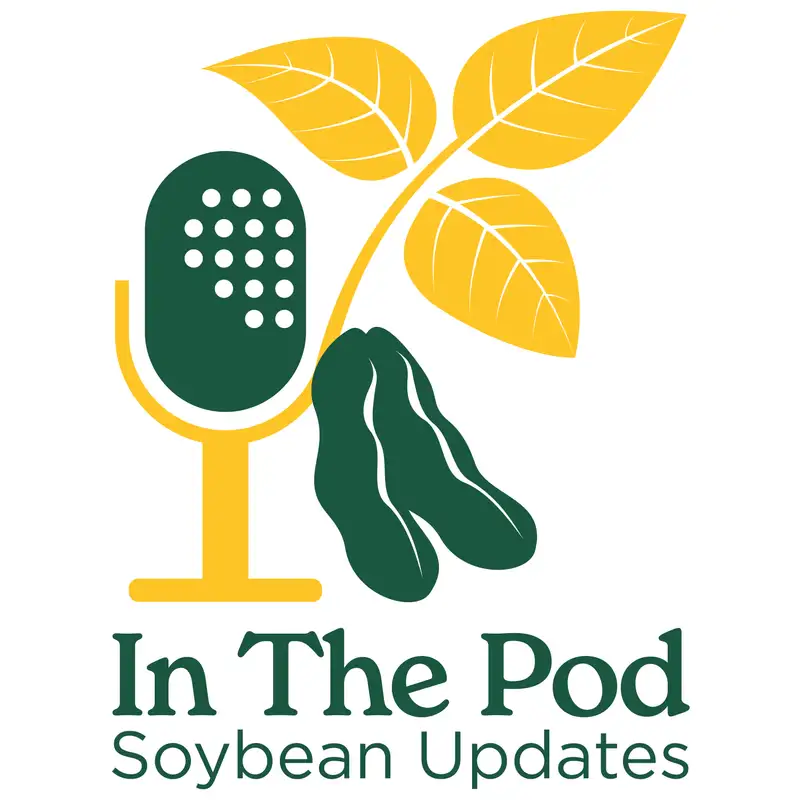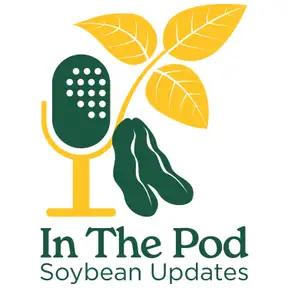06/19/25 Planting into Green: A New Look at Soybean Soil Health
You're listening to In The Pod, soybean updates, a weekly trek into the latest soybean information from NDSU Extension. Planting soybeans into green cover crops is a new practice for many farmers. Chandler Gruener, NDSU Extension's soil health specialist, has more details and an update from North Central North Dakota. Chandler, how are the soybeans doing in the North Central Region?
Chandler Gruener:In the North Central Region, like many of the regions here in the North and North Dakota, are kinda a little bit further behind some various issues across the state, especially over here in the western part, in the North Central Northwest. We had the heavy week of rains like a lot of other places got, but we went from really dry. So some people got planted, but their soybeans really weren't growing or producing or moving up. And then we got all them rains and those cool temperatures so that you're not getting a lot of growth because you're not getting a lot of growing degree units. So growing degree units is them heat units you wanna get to get production of plants, and so that's kinda one way we use to measure it. So we're not getting them growing degree units. Soybeans aren't progressing. Some people actually got delayed. They, you know, they're in the middle planting. These big rains came, so they only gotta finish the second half of their field after. So some people got a little bit of a mix going on. They've got some soybeans that are a couple weeks ahead and some soybeans that are very, very young yet, but v one, v two is kinda like roughly where some of them are. But then there's other people that are just in the cotyledon stage just coming out of the ground. So some of the people that are just coming out of the ground, they got it in right before the rains. They're kinda worried about that crust, you know, that's been talked about a little bit here and there. And so some people are using rollers to kinda push across the ground to kinda push the soybeans, kinda break that soil up to help alleviate that crusting pressure. So it does break down the aggregates. It does crush your aggregates, which kinda goes, you know, a little bit against what you maybe wanna do, but you're also gonna get your soybeans up because that's the ultimate goal is to get good profit off your soybeans. Some other strategies to help dry your soil down and actually change some of the aggregates is using cover crops and then planting green into them.
Bruce Sundeen:Planting soybeans into green cover crops. How does that even work?
Chandler Gruener:Kinda like what I alluded to when they have that cover crops out there, some producers choose instead of terminating it prior to planting, they'll just go out there and plant it in green. So if you have cereal rye, maybe it's just before an antheesis stage, so it's starting to grow, it's starting to mature, but it's not fully there. Maybe it's a little smaller. You know, North Dakota, got variable weather in the spring, so sometimes your cover crop gets high biomass. Sometimes it's light biomass. This year, some of my fields that I had looked at had, you know, pretty good biomass because of the rains. They thought they're gonna have low biomass, but then with the rains, they got delayed planting. So they got a little more biomass out of their syrup rise. So they're getting some them great soil health benefits of the roots running down and creating the aggregation of the soil and stuff like you'd like to see. And so we were tying in some of them soil health principles right there, keeping the ground covered even during the rains, reducing the amount of erosion that could potentially be happening with a lot of them rains, heavy water runoff that could occur. So once they got planted, they just drove straight into it, planted right across the field, cereal rye cover crop is still growing, soybeans are planted. And then you immediately right after go through with a spray of herbicides of the common method. And so they go through and spray it off with herbicides, and then they'll go and roll it to help kinda knock them down in another week or so after the cover crop is dead. And that will actually kinda push the plants down to kinda open up the canopy a little bit more if they've got a really thick biomass. That's kinda something common because people often have them rollers to help push the rocks in or other purposes on their farm. But some people have bought what we call roller crimper. So it's that same roller, but it's got, like, a chevron blade pattern going across it. You can actually use that to roll across the cereal rye or hairy vetch or clover, whatever your cover crop is, and you can roll across, and it'll actually crimp and bend and kill. So when you're crimp bending and killing off your thing, it'll actually reduce the amount of herbicide need to actually terminate that cover crop. But oftentimes, the herbicide strategy up here so this practice is common in the South Of The US, but oftentimes, the practices that used up here, you don't maybe need that as much, and you maybe don't have one of them roller crimpers available to you. You maybe have a roller that you've already bought. And so utilizing the tools you have is always a good way to start when you're breaking into a new practice. And so what it looks like green cover crops kinda looks a little strange. You're planting something greenfield. It's not normal, but it actually can work out with that spray right after and rolling to help knock it down if you got high biomass that you're worried about.
Bruce Sundeen:Chandler, what's the Soil Health Express that NDSU is offering?
Chandler Gruener:So Soil Health Express is NDSU's soil health demonstration trail. It'll be traveling throughout the state. It'll be having demonstrations on erosion, compaction. It'll be having them cover crop roots kinda like we're talking about to and alluding to earlier. So we oftentimes see the above ground biomass, but we don't always see that below ground biomass. So we'll have demonstrations on roots there. We'll also have other great talking points there at the trailer, and this will be at the NDSU field days throughout the summer. And so you can check out the website and social media for NDSU agriculture and find all them dates and locations there.
Bruce Sundeen:Thanks, Chandler. Our guest has been Chandler Gruener, NDSU Extension soil health specialist. You're listening to In The Pod, soybean updates, a weekly trek into the latest soybean information from NDSU Extension supported by the North Dakota Soybean Council.

